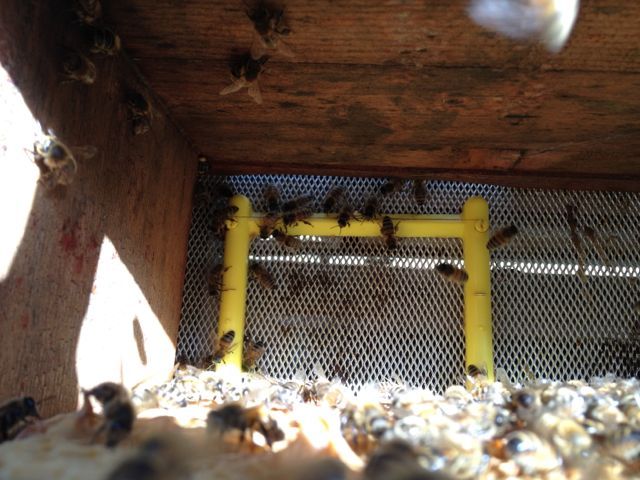New Product Helps Bees Brush Off Mites

A Bee Gym is pictured in a hive. (Photo credit: Bee Gym UK)
Beekeepers can help their bees control their greatest enemy, the varroa mite, through a new product called Bee Gym.
The Bee Gym, distributed by Vita Ltd., provides a low-cost, chemical-free, and sustainable way of helping honeybees groom themselves to get rid of varroa mites.
The Bee Gym is a simple device that is placed inside any hive to encourage bees to groom varroa mites off their bodies. It has wires, flippers, and scrapers on its small plastic frame that bees voluntarily rub their backs and abdomens against to groom themselves of varroa mites. The mites then fall through a normal varroa mesh floor onto a sticky insert or to the ground from where the varroa mites cannot jump back into the hive. The sticky insert should be regularly refreshed and the gym should regularly be cleaned with washing soda.
The Bee Gym is a patented device invented by Stuart Roweth and tested successfully by many beekeepers and beekeeping groups in the UK and further afield.
“When I first saw a bee with a varroa mite on it I was shocked by the mite’s size and immediately thought there must be an engineering solution to help the bees rid themselves of the parasite,” explained Stuart Roweth, beekeeper, lighting engineer, and cameraman with several inventions in his portfolio.
Roweth started with a violin-style bow across the hive entrance and quickly noticed that the bees voluntarily used the wires to scrape varroa mites off their backs. “This was the moment I realized that honeybees could help themselves in the fight against Varroa,” he said. Appreciating that most mites cling to the underside of a bee’s abdomen led him through several versions until he came up with the Bee Gym for insertion inside the hive.
“We have been very surprised and encouraged to see the mite fall directly below the Bee Gym in the hive,” said Max Watkins, Technical Director of Vita (Europe) Ltd. “Clearly the bees are very keen to use the wires and scrapers on the Gym to rid themselves of their No. 1 enemy. As one element of an Integrated Pest Management strategy, it is clearly a very useful, low-cost, and chemical-free varroa-control device.”










